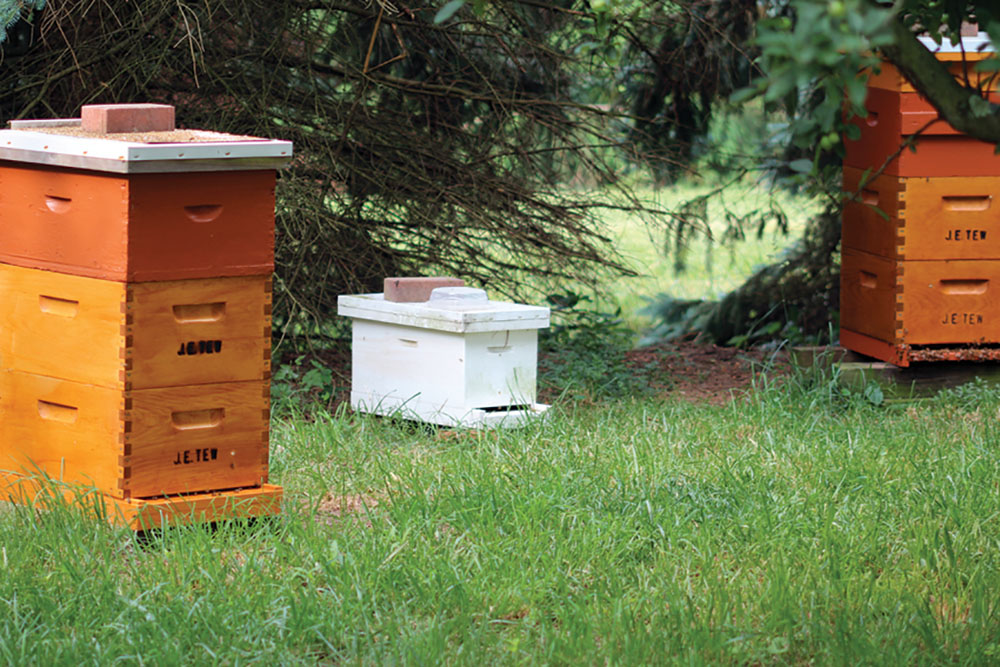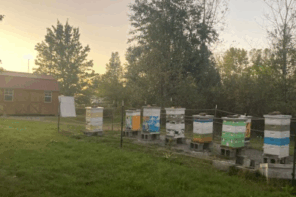When to treat and when to simple accept the disease?
I’m only fooling with you
I am afraid that all too often I write about gloomy things and that my writing persona has become a “poor beekeeper Jim” image. While that may be true, my writing-reasoning is that I tend to write about beekeeping issues that plague us rather than the upbeat success stories – and, yes, there are some of those, too. To me, it feels like things that are going right do not need fixing.
I would argue that we grow in our beekeeping abilities when we make mistakes. When we solve a problem, we are able to mature from those experiences. As I write, I have a colony that I am late Winter-feeding. I am feeding this colony because it is lightweight and the cluster is up high in the equipment. Obviously, I made a miscalculation last Fall. It did not have enough stores to make it through the cold season. In early Winter, I always make my Winter stores estimation as best I can, but sometimes I miss.
Consequently, due to those miscalculations, I have been pushed into learning and developing Winter-feeding techniques (ergo, a mistake that results in growth). As such, I have grown – kicking and screaming – in my beekeeping experience. Where is the adventure in everything always working well? (My ramblings do not mean that everything should go wrong and unlimited errors are okay. Keep things reasonable.)
Disappointing and smelly
The sick colony’s situation was a surprise, but the odor and mess was predictable. The affected colony has been in my apiary for many years – though obviously not the same queen stock or as a perpetual colony. My point is that I had come to assume that this particular colony was fine and would always be a survivor. It appeared to be very unassuming as it wintered – all quiet and covered with snow. Ironically, due to late-season lunacy swarms1, two different colonies of mine needed serious assistance and I gave my attention to them.
For much of the U.S., the Winter cold was impressive this past Winter. Days and days passed with the temperature well below zero. During previous Winters, such coldness did not appear to result in a massive colony die-off so I was reasonably sure that most of my colonies would survive.
The weather broke and bees began to take cleansing flights and what a mess they made. They really needed to cleanse themselves. The two late season swarmers were dead. No surprise there. They nearly deserved their fate. But I did not expect dysentery from the unassuming colony.
What now?
Part of my plan from last year was to leave all my colonies dead heavy with honey stores. This sick colony is packed with honey stores. Maybe something was wrong with some or all of these stores, but why are the other colonies not showing it as badly or not at all? All of my colonies had access to the same floral sources.
For all of the dead bees in and around the colony and the fecal mess on the colony, the questionable colony is still surprisingly strong. To lessen even more stress, I have not gone deeply into it so I can’t say exactly how strong. If it can survive, I will let it develop longer into the Spring before I open it.
Other more energetic beekeepers would take samples to determine if a form of Nosema had overtaken the colony. Of the 15 colonies in my apiary, this is the only one that scoured. It is simply one of the unknowns of this past Winter. I will clean the hive as best I can and I will check the stores to visually see if I find anything I don’t like. If necessary, I will discard some frames or require the bees to build new wax combs. I doubt I will do much more than that. During other years, I have been through all of this before.
It was in 1975 or so . . .
During 1975 or 1976, I was new to the academic program at the University of Maryland in College Park, Maryland. Dr. Dewey Caron was (still is) my major professor. Normally about 10 to 15 colonies sat in front of the university apiary. During an uneventful late Winter one of the colonies went wild with dysentery. As such, dysentery is a symptom and not truly a disease any more than a stomach ache is a disease. I had aspirations of becoming a honey bee academician so I felt a need to solve this mystery.
I took scrapings and other samples and bothered everyone I could within the department who I felt could help. As the investigative weeks passed, the sickly colony died. Even more weeks later, a diagnosis was developed that seemed plausible. The honey stores contained a high melizitose (a sugar that bees do not digest well) level that most likely came from a honeydew source. The colony was wintering on poor stores. So there – I now had an academically derived (possible) answer to the problem. I had used a lot of my time and that of others and had invested funding in determining that the dead bees died of causes beyond my control. To this day, that experience dampens my eagerness to perform complicated treatments for dysenteric diseases such as Nosema.
Now what to do?
Each beekeeper will go one of several ways – (1) do something, (2) do nothing, or (3) not sure what to do or not do. To see where things are, search honey bee dysentery or Nosema on the web. Of interest within these research results will be the paucity of hits from traditional academic institutions. The usual bee people are writing the usual in-depth articles that offer information that is not always practical as a solution for all beekeepers. Other articles provide complicated “field evaluation” sessions that actually require a microscope in the field. It becomes unclear what should be done.
Several diseases or issues can cause dysenteric symptoms. Now, there are two forms of Nosema. For the typical beekeeper, both are hard to conclusively diagnose. Researchers report that in some cases, simple cold weather is enough to lower the infection rate of the newer form of this pathogen and that a control solution may not even needed. I know of occasional passionate beekeepers who have actually purchased compound microscopes and related equipment to analyze the level and type of Nosema at hand. Even with a scope, it is remarkably difficult to derive a conclusive diagnosis and even then a control plan has not yet been developed.2
So where does that leave me now?
As the decades have passed, other instances of dysentery have shown up in my bees. To monitor for Nosema, I did occasionally pull guts and take spore counts. At times, I went through the treatment process with Fumadil-B3. I always ended tinkering with a diagnosis while my colonies dealt with the issue on their own. Normally, they recovered, but yes, occasionally some of these afflicted colonies died.
Unless something else arises, I suppose my practical plan for this colony is to employ the traditional management scheme to feed the colony and encourage its recovery in any managerial way possible. I am not inclined to perform extensive in-apiary testing and evaluation procedures. I will do what I can to keep all of the colonies healthy and productive. I will not always be successful.
Altering my apiary layout
My Alabama heritage frequently shows through in my apiary. I like shade. In south Alabama, beehives in the sun are hot, hot locations during Summer months. The bees are also hot and testy. Full protective gear has to be worn at all times. Working bees in the early morning or late afternoon becomes the norm – or put the apiary in the shade where things are somewhat cooler.
Even though I now live in Ohio, my home apiary now is still in the shade. In Ohio, there are many Summer days when the weather is hot. The shade is still nice. However, more important to me, my apiary is in the deep shade and out of respect for my neighbors, secluded in the back corner of my property. Out of sight – out of mind. Don’t panic. I am not writing on that subject here in this article.
I’m adding a stockade fence
This Spring, I plan to add a barrier fence so I can move my beehives into more direct sunlight and out of the deep shade they are now in. I’m serious about this fence building for several reasons: neighbors, grandkids, and beehives. I have contracted with a company to do the job but not without disruption. I will have to move the colonies from the work site until the project is finished. I hope the occasional sunny Winter day gives my colonies a bit of a respite from the cold. As you would probably expect, I will write future articles on this fence caper.
I’m raising my hives higher off the ground
My entire bee life, I have used cement blocks or some type of treated wood hive stand. Keeping colonies near the ground makes it easier to put supers on and then to remove supers. I have a constant problem with critters. My apiary is near a woodpile, wild brush, and trees with low-growing branches. The vermin of the area feel that I have provided these resources for them. When these animals can move about, my colonies are relentlessly harassed. I don’t know how much this disrupts my wintering bees, but I will try to inconvenience the critters as much as possible.
I would like to come up with design for individual stands rather than the communal stands that I now use. If any of you have an idea for such a hive stand, I would enjoy having a look at it.
Back to the water issue – again
I have written about providing water for bees until you and I both are exhausted on the subject. Yet I must add that providing a small, but dependable water source for bees can be a potential site for disease spread. I suppose it would be a bit like everyone drinking from the same water glass. But as usual, I am not prepared to say that this is a common source of disease spread such as Nosema or related dysentery-causing issues. But it looks like it could be.
Many years ago, a USDA scientist, now long retired, made the passing comment that he routinely found what he felt were pathological spirochetes (a bacterial type) in the nectar of poplar trees. He wondered if diseases could be spread in nectar.
Much more recently, there are exciting discoveries indicating that healthy bees have beneficial gut bacteria that help suppress the pathological bacteria that bees encounter in their natural lives. The project hope is that an inoculum can be developed that will encourage the “good” bacteria and suppress disease-causing pathogens.4 I’m telling you all of this because my water improvement project could very well be JTew “busy work.” Most experienced beekeepers have seen some of the places that bees collect water. It’s not always pretty sources.
Sustainable beekeeping – my way
I think I can expect my bee life to continue as it has during many past years. I will wonder why this colony experienced this stress. I will do what I can to boost my surviving colonies. If necessary, I will make some splits, and if even more necessary, I will possibly buy a few packages or some splits. One way or another, I will sustain my bee operation as I have done for the past 40 years or so.
But know this . . .
If this situation gets worse within the next season or two, I will explore treatment options. I can’t just let the situation get worse and worse. But if it is just this one and all other colonies seem normal this season and next Winter, I will simply let things slide.
Dr. James E. Tew, State Specialist, Beekeeping, The Alabama Cooperative Extension System, Auburn University; Tewbee2@gmail.com; http://www.onetew.com; One Tew Bee RSS Feed (www.onetew.com/feed/); http://www.facebook.com/tewbee2; @onetewbee














